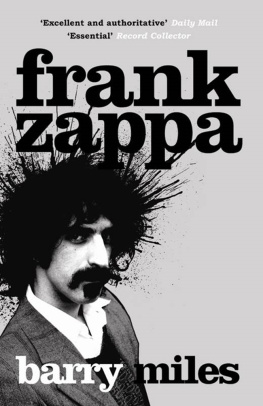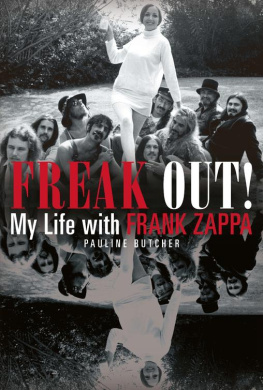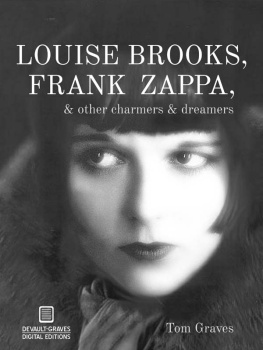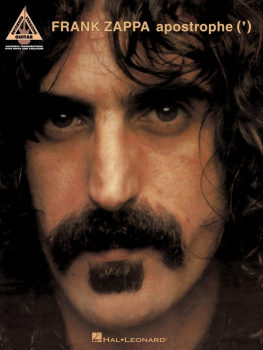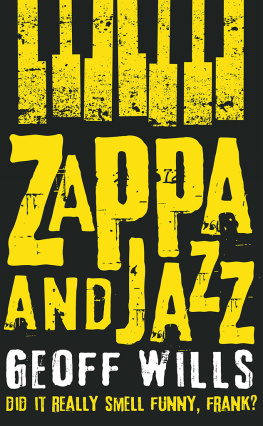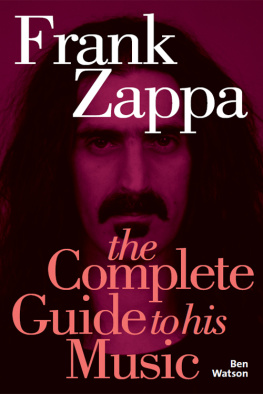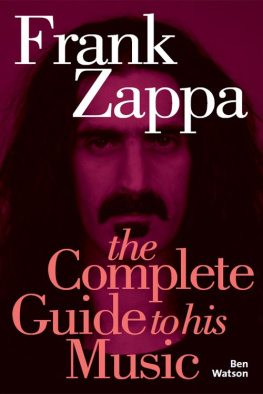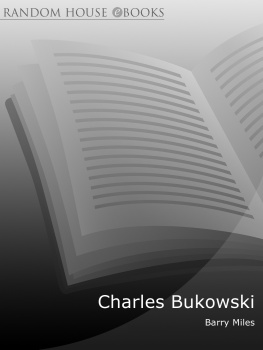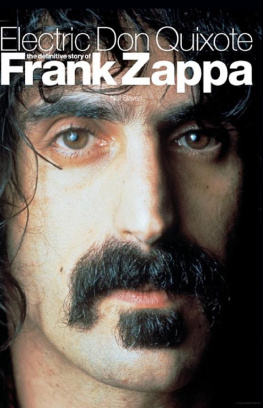Frank Zappa
Barry Miles is one of the most famous biographers of the sixties and seventies music scene. He is also one of the few writers to have been intimately acquainted with the rock stars whose lives he has chronicled. He knew Frank Zappa well and was present at many recording sessions, including the recording of Hot Rats.
Miles is the author of a number of seminal books on popular culture. His books include the authorised biography of Paul McCartney, Paul McCartney: Many Years from Now, Ginsberg: A Biography, Jack Kerouac: King of the Beats, In the Sixties, The Beat Hotel: Ginsberg, Burroughs and Corso in Paris, 19571963 and Hippie which was published in 2003.
Excellent while its hard to warm to such a smartarse misanthrope, the book makes you realise what a uniquely talented musician Zappa was. Sunday Times
I am a big rock biography fan, and Frank Zappa was one of my heroes. The Barry Miles book made me look at him in an entirely different way. It is a serious work about a man who deserves to be treated seriously. Matthew Wright, Daily Express
Funny and revealing Evening Standard
Barry Miles prose style is lucid and unflustered the perfect foil for the outlandish tales it comes to tell. Arena

First published in Great Britain in 2004
by Atlantic Books, an imprint of Grove Atlantic Ltd.
This paperback edition, with revisions and corrections,
published by Atlantic Books in 2005
This digital edition published in Great Britain in 2014
by Atlantic Books Ltd.
Copyright Barry Miles 2004
The moral right of Barry Miles to be identified as the author of this work has been asserted in accordance with the Copyright, Designs and Patents Act of 1988.
All rights reserved. No part of this publication may be reproduced, stored ina retrieval system, or transmitted in any form or by any means, electronic, mechanical, photocopying, recording, or otherwise, without the prior permission of both the copyright owner and the above publisher of this book.
Every effort has been made to trace or contact all copyright-holders. The publishers will be pleased to make good any omissions or rectify any mistakes brought to their attention at the earliest opportunity.
A CIP catalogue record for this book is available from the British Library
eISBN 9781782396789
Designed by Richard Marston
Atlantic Books Ltd
Ormond House
2627 Boswell Street
London W C1 N 3 J Z
www.atlantic-books.co.uk
To David Walley, Urban Gwerder, Alain Dister and Mick Farren; pioneer Zappaists.
Contents
Illustrations
| Frontispiece: Frank Zappa (Michael Ochs/Redferns) |
| 1 | Baby Frank |
| 2 | Frank and family |
| 3 | Frank at graduation |
| 4 | 1819 Bellevue Avenue, Echo Park |
| 5 | The Canyon Store, Laurel Canyon Blvd |
| 6 | Frank and his brothers |
| 7 | Frank with his early band, the Black-Outs c. 1957 |
| 8 | Frank and Gail living in New York, 1968 |
| 9 | Frank with bull on the set for Head |
| 10 | Edgard Varse |
| 11 | Composer Igor Stravinsky at rehearsal |
| 12 | Frank and his Mum |
| 13 | Frank and his Wife |
| 14 | Frank at home with his children |
| 15 | Frank and the Mothers at rehearsal |
| 16 | Frank conducts the LSO |
| 17 | Frank in Paris in the early seventies |
| 18 | Frank in London, 1967 |
| 19 | Frank with William Burroughs at the Nova Convention, New York, November 1978 |
| 20 | Frank reading from Burroughs Naked Lunch, New York City, November 1978 |
| 21 | Frank testifying at senate hearing |
| 22 | Frank Zappa as guitar hero |
Introduction
In 1965 Cucamonga was just a village: a few streets clustered either side of Foothill Boulevard, historic Route 66, where it crossed Archibald Avenue about 75 miles east of Los Angeles. Around 7,000 people were scattered in the suburban desert sprawl that extended all the way to LA and connected the twin towns of Ontario-Upland to the west and San Bernardino to the east. Though this was the mid-sixties, the Cucamongans lived in a fifties time warp. It was a conservative, right-wing village and the male population wore short-sleeved white shirts and bow ties. Even a T-shirt was looked upon with suspicion. Cucamonga had a high school, a court house, a holy-roller church, a malt-shop and a recording studio, Studio Z, built by local boy Paul Buff, but now owned by 24-year-old Frank Zappa.
Business was slack: few Cucamongans wanted to record their bands, even at the very reasonable rate of $13.50 an hour, so Frank had to drive 75 miles to Sun Village in the High Mojave Desert every weekend where he earned $7 a night playing in a bar band. With him in the studio lived his 18-year-old girlfriend Lorraine Belcher and his high-school friend Jim Motorhead Sherwood.
One of Zappas schemes was for a low budget science-fiction movie: Captain Beefheart Versus the Grunt People, starring Captain Beefheart (aka Don Vliet) and his parents. Zappa had bought $50-worth of stage flats that took up much of the back room of Studio Z, and had painted them with cartoon designs for a rocket ship and a mad scientists lab. Despite having no money, he had confidently announced a casting call for the movie. This drew the attention of the local police. Tipped-off by the Cucamonga police department, Detective Sgt Jim Willis from the San Bernardino sheriffs office vice squad auditioned for the part of Senator Gurney (the role of the asshole, as Zappa put it) and was convinced he had uncovered a vice den.
To Sgt Willis, Studio Z looked like a bohemian pad. The walls were covered with newspaper clippings and memorabilia: a threat from the Department of Motor Vehicles to revoke Zappas drivers licence, his divorce papers, a still of him on The Steve Allen Show, rejection letters from several music publishers, pop art collages and song lyrics. One was The Streets of Fontana, a parody of the folk music standard The Streets of Laredo, which Zappa used to sing with Ray Collins in the local clubs as a joke.
As I was out sweeping the streets of Fontana
As I was out sweeping Fontana one day
I spied in the gutter a mouldy banana
And with the peeling I started to play...
To Sgt Willis this was no joke. Zappa was clearly a threat to society. He ordered a surveillance team to drill a hole in the wall of the studio and for several weeks undercover police gathered evidence of subversive behaviour.
Then Sgt Willis visited the studio, this time in the guise of a used-car salesman. Attracted by the smart sign over the door (TV PICTURES), he explained that he and the boys were having a little party and wondered if Zappa could make him an exciting film to suit the occasion. Zappa who was living on peanut-butter sandwiches and instant mashed potatoes scrounged by Motorhead from the blood-donor centre rapidly calculated that such a film would cost $300 to make. This was beyond the budget of the San Bernardino vice squad, so Zappa suggested that a tape-recording might suffice and would cost only $100.

